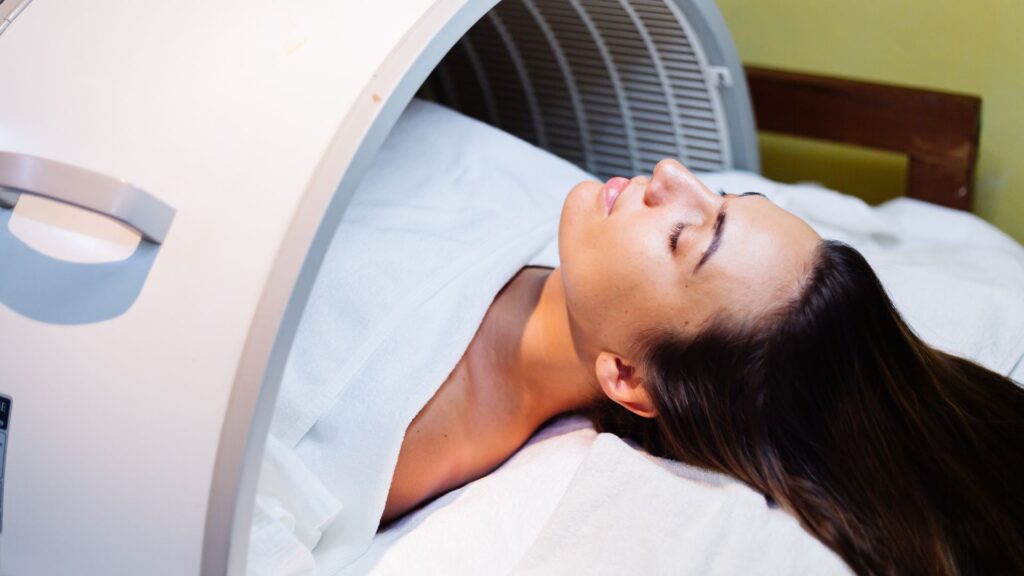Theta Chamber Therapy is a modern intervention that blends neuroscience with advanced technology to guide the brain into a restorative theta wave state. These states promote neuroplasticity, allowing the brain to reorganize itself and form new pathways, an ability crucial for healing, learning, and recovery.
This article explains its potential benefits, as this process has gained attention in wellness practices, mental health care, and addiction recovery programs.

How Does the Theta Chamber Work?
The Theta Chamber works by combining multiple sensory modalities to guide the brain into the deeply restorative brainwave state. This brainwave pattern, typically measured between 4–8 Hz, is associated with deep meditation, enhanced creativity, and emotional processing.
It uses synchronized light and sound therapy, including binaural beats, to quickly induce theta waves, which are associated with deep relaxation, creativity, and heightened receptivity. The chamber gently spins at about 13 revolutions per minute—a motion called vestibular stimulation—that disrupts the brain’s normal sense of time and space, enhancing relaxation and openness.
It also uses cranial electrotherapy stimulation (CES), which delivers mild electrical pulses to promote healthy neurotransmitter levels, helping to reduce anxiety and depression. Through this multi-modal approach, the device creates optimal conditions for healing, learning, and neural pathway reestablishment in a safe, non-invasive manner.
Reduction of Anxiety and Stress
One of the most well-documented effects of theta states is their role in stress reduction. Studies on meditation and binaural beats, which are also used in the chamber, show that these techniques can lower cortisol levels, increase heart rate variability, and promote relaxation.
The chamber helps regulate the body’s stress response by engaging the parasympathetic nervous system. This produces a profound sense of calm during and after sessions. Regular exposure may eventually help individuals maintain lower baseline anxiety levels and develop greater emotional resilience.
For those seeking innovative approaches to mental wellness, theta chamber therapy provides a setting where these scientifically supported techniques can be experienced in an immersive and structured way.
Relief from Depression and PTSD Symptoms
Depression and post-traumatic stress disorder are often linked to a rigid brainwave state and difficulty processing conditions like trauma. Therapeutic environments encouraging theta activity can increase serotonin and dopamine release, improving mood regulation. The chamber’s immersive combination of light, sound, and microcurrents may help bypass conscious defenses, allowing the brain to process unresolved trauma more effectively.
This can reduce intrusive thoughts, emotional numbing, and hypervigilance, symptoms commonly reported in PTSD. The technology promotes neural rewiring and restores chemical balance in the brain, supporting long-lasting relief from depressive symptoms. While not a substitute for clinical care, it may serve as a powerful adjunct to therapy or medication.
Improved Emotional Regulation
Emotional regulation is essential for mental health, yet many people struggle with lingering negative thought patterns. Research in neurofeedback and hypnosis shows that theta activity improves receptivity to positive reframing and behavioral change. As a result, users often report feeling less reactive and more grounded in daily life, with greater control over anger, sadness, and frustration.
Enhanced Focus, Creativity, and Cognitive Clarity
The link between theta states and creativity has been widely studied. Neuroscientists have found that increased activity correlates with problem-solving, memory consolidation, and bursts of innovative thinking.
Due to the quieting of external distractions, the chamber helps the brain enter this state more efficiently. Writers, artists, and professionals often describe breakthroughs in creativity, while students and knowledge workers benefit from improved concentration, memory retention, and learning efficiency.
Support for Addiction Recovery
In addiction science, cravings and relapse risk are closely tied to ingrained nerve cells. Research on neuroplasticity indicates that the brain’s ability to “rewire” new neural pathways is heightened in the brainwave state. The chamber uses this flexibility to weaken associations between substance use and reward, while strengthening healthier coping mechanisms.
Some recovery programs use this method to reduce withdrawal discomfort and reinforce long-term sobriety when combined with counseling, group support, or medication-assisted treatment.

Relief from Chronic Pain
Chronic pain conditions such as fibromyalgia and migraines are often linked to heightened nervous system activity and inflammation. Technologies like cranial electrotherapy stimulation, which is similar to the chamber’s microcurrents, have been studied for their ability to reduce pain perception by altering neural signaling.
Vibration therapy, also incorporated in this method, is known to improve circulation and relax muscle tension. Together, these elements may interrupt pain cycles and promote relief, offering a non-pharmacological complement for people living with persistent pain.
Better Sleep Quality
Poor sleep has wide-ranging health consequences, from impaired cognitive function to weakened immunity. This therapy encourages the brain to generate slower wave patterns, improving circadian regulation and supporting the natural transition into restorative sleep stages.
Studies on binaural beats and light therapy have shown improvements in sleep onset and sleep quality, with participants reporting deeper rest and greater alertness the next day. Regular sessions may help reset unhealthy sleep cycles.
Cellular Regeneration and Healing
The theta pod incorporates technologies believed to operate on a cellular level. Research in photobiomodulation (light therapy) shows that exposure to specific wavelengths can stimulate mitochondrial activity, enhancing energy production and cell repair.
Similarly, microcurrents have been studied for their ability to reduce inflammation and accelerate wound healing. While more clinical trials are needed, early evidence suggests these combined modalities may support faster recovery from illness or injury and promote general vitality.
What to Expect During a Theta Chamber Session
A standard session lasts 30–60 minutes. Participants recline comfortably while synchronized light, sound frequencies, vibration, and gentle currents guide the brain into the desired range. Many report immediate relaxation and improved clarity of thought.
Longer-term benefits, such as reduced anxiety, deeper relaxation during treatment, or improved sleep, often develop with repeated use. This approach is frequently considered by individuals seeking mental health support, addiction recovery tools, pain management, or holistic wellness enhancement.
Like many therapeutic interventions, there may be side effects. Short-term effects can include mild dizziness, temporary disorientation, or heightened emotions immediately after a session. These experiences are generally brief and resolve on their own. Long-term effects include changes in sleep patterns, emotional sensitivity, or increased vividness in dreams after multiple sessions. While these are typically manageable, anyone with underlying medical or psychiatric conditions should consult a qualified healthcare provider before beginning therapy.
Final Thoughts from Quantum Wellness Center
Theta Chamber technology offers a range of potential benefits, from reducing stress and anxiety to supporting emotional regulation, aiding addiction recovery, improving sleep, and promoting overall wellness. Guiding the brain into the theta state creates an environment that may facilitate both psychological balance and physical healing.
At Quantum Wellness Center, we provide this technology with the goal of fostering optimal conditions for restorative brain activity. Through the integration of light, sound, and microcurrents, key elements often associated with quantum wellness, this approach encourages measurable shifts in mental clarity, emotional stability, and physical well-being.



